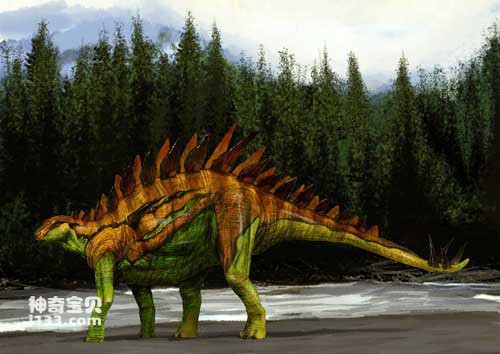Huayangosaurus is the earliest complete Stegosaurus skeleton discovered in the world. Its discovery provides evidence for the theory that Stegosaurus originated in East Asia. However, Huayangosaurus's status in the origin of Stegosaurus still needs to be verified.
In the Middle Jurassic, the banks of some rivers were often covered with dwarf ferns, like a green carpet. For Huayang Dragon, this is a paradise for them to live. Those short ferns are very suitable for its small grinding teeth and are very delicious to eat. However, when they enjoy delicacies here, they often become the coveted delicacies of predators such as air dragons. Therefore, they live in small groups to defend themselves against enemies. Generally, a group of 3 to 5 Huayang dragons can be formed, with a male Huayang dragon as the leader, and the other members are usually adult female Huayang dragons and young dragons. The little Huayang dragon follows its parents closely, because the adult Huayang dragon has its own weapons to deal with those hateful natural enemies, so those who have ulterior motives are afraid to attack easily.
So, what kind of "defensive" weapons do adult Huayang dragons have on their bodies? It turns out that these little men who walked on short and thick limbs were actually one of the earliest stegosaurs in history. In the process of their evolution, a unique set of defensive weapons has evolved on their backs from the neck to the middle of the tail, which are long, symmetrical rows of triangular bone plates, and an extra one on each shoulder. The tail has thorns, and the end of the tail has four sharp spike-like ridges of nearly 40 cm. Such equipment is scary enough just to look at it.
When the hungry air dragon attempts to attack the Huayang dragon, the Huayang dragon will adjust its body to the appropriate position and aim its long bone plates at the attacker. The color of the bone plate quickly turned bright red due to congestion. This was not only the most severe physical warning of Huayang Dragon, but also a posture only adopted in times of crisis. At the same time, they swayed their shoulders to make the large spines on their shoulders more eye-catching; they also swung their tails vigorously to make the four eye-catching spike-like ridges swing back and forth in front of the air dragon's eyes. At the same time, it will find the right opportunity to whip its natural enemies with its tail, or kick the ground with its limbs and sweep the ground with its tail, sweeping the water and plant debris from the puddles on the ground into the air.
Although these defensive measures are not powerful enough to kill large intruders, this formation can produce a sufficient deterrent effect, confusing those natural enemies who rush to attack: How can such cowardly and easily bullied guys do this? Suddenly so creepy? Usually, unless hunger becomes unbearable, these offenders will stop attacking in order to avoid injury and instead look for easier prey.
Although stegosaurs likely appeared in the Early Jurassic, paleontologists' attention to their origin and evolution actually began with the Huayangosaurus unearthed in Dashanpu, Zigong, Sichuan, China. In 1980, the first skull fossil of Huayangosaurus was discovered in China. Since then, paleontologists have discovered more bone fossils. A total of 12 Huayangosaurus individuals were excavated in Dashanpu, and the two complete skeletons are displayed in the Zigong Dinosaur Museum and the Chongqing Natural History Museum.

Chinese name: Huayang Dragon
Latin name: Huayangosaurus
Age of survival: Middle Jurassic
Fossil origin: Sichuan, China
Physical characteristics: 4.3 meters long
Diet: plants
Species: Stegosaurus
Definition: Dedicated to the ancient Huayang Kingdom
animal tags: Huayangosaurus
We created this article in conjunction with AI technology, then made sure it was fact-checked and edited by a Animals Top editor.